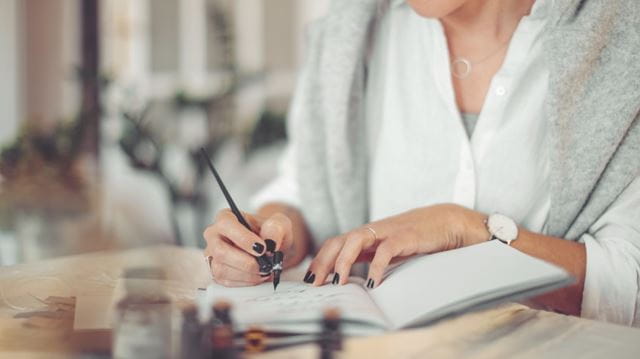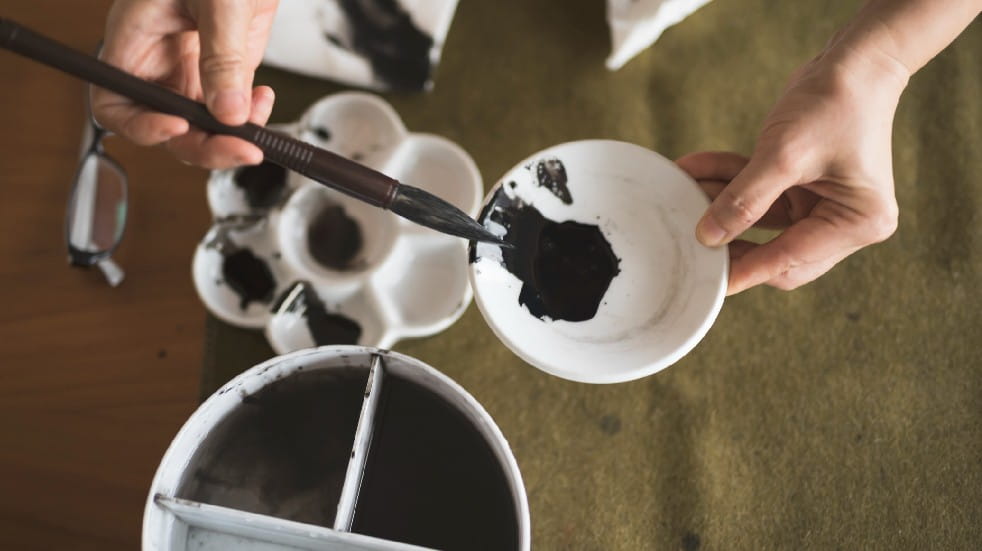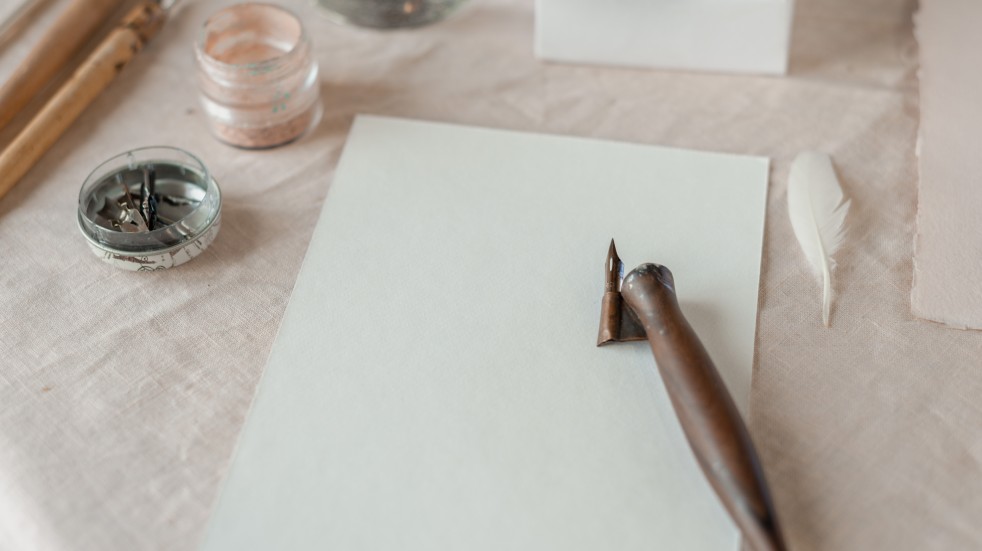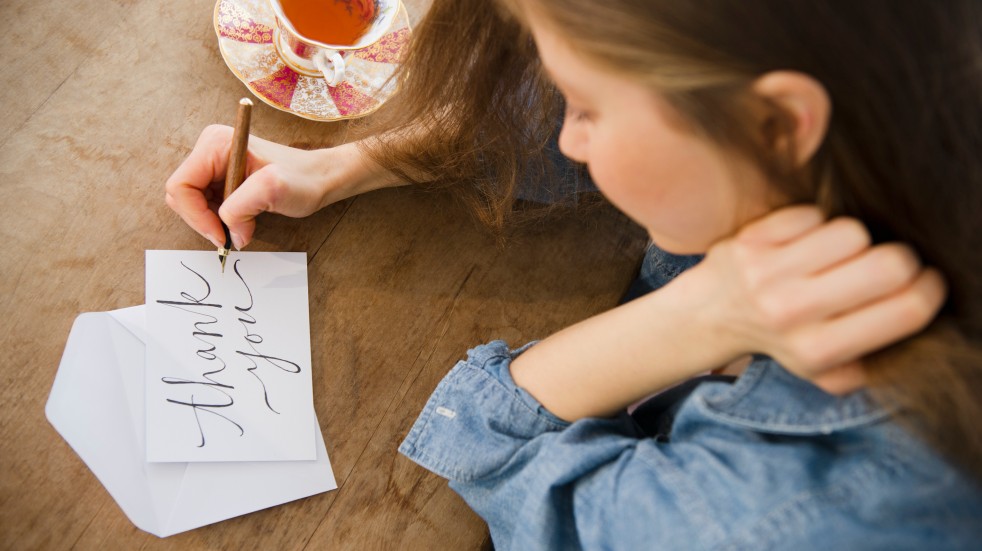
An introduction to calligraphy from expert Kirsten Burke who provides advice and inspiration for beginners as well as insight into the wellbeing benefits the practice can bring
From the satisfaction of learning a new skill to giving you an opportunity to slow down and free your mind from everyday worries, calligraphy can leave you feeling calmer, and with some beautiful results to show for it.
I was always fascinated by the written word. As a child, I struggled with spelling, so I would focus on styling my letterforms instead, enjoying the visual impact words have on a page. I have been lucky enough to spend my working life creating beautiful lettering. From greeting cards to large-scale public artworks, my passion is to create bold, vibrant artworks inspired by the meaning of the words.
I love the deeply therapeutic nature of calligraphy. The ebb and flow of the pen allows me to get lost in the piece I’m creating. Like any art form, it requires dedication, sharpening your faculties as skills that you may not have trained before are developed – and there’s no better time to start.
Summer’s end, as the evenings draw in, is a wonderful time of year to begin a new hobby and this low-cost, low-commitment pastime is back in favour. Not only is the outcome rewarding, the process of creating calligraphy is also a joy in itself; it’s time spent enjoying the peace, away from TV and computer screens – just you and your pen. You’ll discover immeasurable satisfaction in learning, too.
In the past, calligraphy was perceived to be guarded by elitists insisting it must take years to learn and perfect your skills, which, of course, would put most of us off picking up a pen.
The Victorians admired medieval manuscripts such as The Lindisfarne Gospels, but misunderstood how the letterforms were created. When trying to emulate the alphabets they would draw an outline, and then fill it in. It was Edward Johnston OBE who realised the manuscripts were made using a broad-edged nib, which created the contrast between thick and thin strokes in single movements. His influence on typography and calligraphy today is undisputed; his book Writing & Illuminating, & Lettering (1906) contained clear and practical information on writing
procedures, as well as aesthetics, kick-starting a revival in the art of traditional calligraphy.
The formal styles focused on forming each letter to be identical to the last. This uniformity was admired in the past but, now that a computer can do a successful version of this in a fraction of the time, a shift has taken place. The digital age has given rise to greater awareness about design and easier access to amazing ideas and styles. There’s a renaissance in calligraphy right now, due in part to the new hybrid style now known as ‘modern calligraphy’.
All the gear
What you need to get started…

You don’t need many tools or much space for calligraphy, so this is an inexpensive hobby, and its growing popularity makes equipment easy to find.
Pointed nibs
There are hundreds of them and you can try them all once you have learnt the basics. To begin with, I recommend a Leonardt 30 nib available at Blots Pens – it’s perfect for beginners as it’s easy to use, and flexible enough to give you great contrast of line.
Brush pens
If you’re nervous about using a nib and ink, you can get similar results with a brush pen. With a flexible tip, it reacts much the same way as a pointed nib. Available from Cult Pens the Pentel Fude Touch is lovely to use and writes to the scale of a nib.
Papers
Rhodia pads which can be found at Jackson’s Art are the perfect paper for calligraphy. Their smooth surface allows the nib of your pen to flow across the page without the ink feathering or seeping through to the other side: they’re a good option for beginners.
Inks
If you’re in London, visit the long-standing shop L Cornelissen & Son for an array of inks and pigments. In the heart of the city, it’s a stone’s throw from The British Museum, or you can order its products online.
A bit of everything
My website The Modern Calligraphy Co has a range of my own kits available to buy, as well as brush pens, nibs and inks that I have had specially made. I stock materials that I believe are the best for all calligraphers, including beginners.
Out with the old...

The traditional calligraphy that you see in ancient documents on display in museums was made with a broad edge nib (a nib with a wide, flat end instead of a point). This is held at a consistent angle to create the thick and thin strokes. The key to modern calligraphy, however, is that it’s written with a pointed nib; this comes to a sharp point and you create the thick and thin lines by pressing harder or softer as you go up and down. It is also called a ‘dip pen’, as you dip it into ink. As the nib has a point, it can be used by both the right- and left-handed.
Revived to create a chic, informal style of lettering, the pointed nib was originally used for copperplate calligraphy, a ‘flourishy’, formal style. The modern calligrapher has adopted this tool, thrown out the formal rules, and added their own personality to their work, to develop a much more accessible way of working.
Today’s version of calligraphy doesn’t follow the strict rules that govern the traditional style. The lettering still needs to be balanced, but each letter doesn’t have to be identical every time it’s written; it is about learning to play with the rules. It doesn’t matter if your handwriting is terrible or you’re not artistic. The fun thing is that it doesn’t need to be perfect – it’s the imperfections that make it so human, and that is the appeal.
Because you immerse yourself in what you are creating, calligraphy affords the perfect escape. You get so absorbed in what you’re doing that you can forget about everything else. The focus of the mind on the rhythm of the pen, as you make the letter strokes, helps free up headspace. When concentrating on the shape of the letterform, making the pen work, and remembering to correctly spell the words you are writing, all other thoughts are pushed from your mind. That is why calligraphy is so relaxing.
Getting started
For complete beginners, pointed-nib calligraphy is the best place to start. You learn the processes that are fundamental to all modern calligraphy, but because the nib forces you to go slowly, it is a good way to begin. The nib keeps you working slowly and with focus.
Next steps: brush pens
The brush pen is the free-spirited version of the nib. Once you understand the basic principles, begin to experiment with brush pens. Just like a nib, the thick and thin lines that make calligraphy distinctive are made by changing the pressure applied. These are handy for when you’re on the go: as there’s no need to carry inks or water, the brush pen is wonderfully convenient.
Take up a paintbrush
Already arty? Learn to create calligraphy with a paintbrush and apply lettering to any surface, from plant pots to fabrics to wooden signs. It also means you can dip into any ink or paint, so there is no limit to the colours you can use.
Make it formal
If modern calligraphy has sparked an interest, then how about trying a more formal style? From blackletter to swirling copperplate scripts, calligraphy comes in all shapes and sizes, so whether you want to look back into the history of lettering or play with new, emerging styles, it’s wonderful to put pen to paper and use our hands to write beautiful things.
How to begin

First, decide how you would be most comfortable learning: either face-to-face at a local calligraphy class, a virtual class that’s live streamed, or you might prefer a pre-recorded class, so that you can stop and start, and fit learning around your other commitments. Little and often is the best way to improve – just 10 minutes a day is enough.
Really think about your technique and what you are doing, eliminating bad habits and making small adjustments, so that your style and flow improve. Drills are the repetitive practice that’s required to learn the art of beautiful and expressive calligraphy. These conscious marks build the automatic response to press harder on the down stroke and lighter when moving the pen upwards. They’re a good way to develop this technique and, when you can’t think what to write, just make patterns with the nib so that you learn to control it and understand how to get the best from it.
Beginners tend to grip the pen tightly as they may be nervous, but this can make you wobble, so as you gain the confidence to loosen your grip and relax, you will achieve better results. If you find it hard to write because of limited movement or pain, then adapting the pen holder with a gripper can help. Work slowly, focus on each stroke, and you will soon begin to build up the muscle memory that will help your calligraphy improve and become more consistent.
Sitting down to write can be considered similar to meditation. Calligraphy requires you to slow down, which allows you to create a space of self-care and let your mind unwind. As technology pushes us to go faster, lifestyle and wellness trends focus on listening to the need for balance, self-recognition, living in harmony with oneself and the environment, so calligraphy is now being recognised as a part of this movement: a practice of wellbeing.
Total immersion
Four ways to inspire and inform…
Attend a workshop
Having a tutor show you exactly where to make minor adjustments to your angles and positioning can make all the difference to picking up calligraphy quickly. Learning together means you can chat about your lettering and get inspiration from each other, so it can be a great way of making new friends, too.
Buy a book
There is an array of books available teaching calligraphy. Whether you choose to learn directly from them, or use them as a reinforcement of what you have already learned in a class, they will offer you ideas for different ways to practise, and projects for you to apply your new skills.
Use social media
Instagram is a fantastic platform for sharing your own calligraphic work. Photograph your calligraphy and show the world your results, or simply browse what others are doing to get new ideas. Pinterest also has all sorts of ideas, free downloads and tutorials to help and inspire you.
Learn online
In live-streamed or pre-recorded online workshops – such as Stacy Oakley’s 90-minute session for Virgin Experience Days, which was attended by the members featured on these pages – you can take part without leaving home. The kit is sent to you, and you join the workshop via Zoom or a similar platform.
Club mentality

During lockdown, a thriving community of calligraphy enthusiasts developed online, and, now that Covid restrictions are easing, hopefully these communities will be able to meet face-to-face. There are calligraphy groups on Facebook where members share work and feedback. How about setting up evening meets in a local hall or art space to get together and practise your lettering?
There are also national craft fairs, such as The Creative Craft show, visiting Exeter, Birmingham, Manchester and London. Attendees can join in with all sorts of different workshops, including calligraphy.
If you’ve really got the bug, you could immerse yourself in a three-day course at the internationally-recognised West Dean College in West Sussex. Look out for online calligraphy clubs set up by professional calligraphers, where members can chat together in private forums, and have access to one-on-one and group classes with their tutor, free downloadable content like alphabets and artworks, and trouble-shooting sessions. (Note, the term ‘modern’ encompasses calligraphy created using a pointed nib, a paintbrush, or a brush pen.)
Your expert
Kirsten Burke is a world-renowned calligraphic artist, working with leading luxury brands. Through The Modern Calligraphy Company, she aims to inspire beginners and professionals to develop their skills.
Do more with Boundless
20% off with virgin experience days
The calligraphy workshop attended by Boundless members is just one of many new skills you could learn through Virgin Experience Days – the saving applies to a range of online experiences as well as days out and more.
Fancy taking up a new hobby? Save 7% on a huge range of books coveringa multitude of different pastimes, including calligraphy, at stores including Waterstones and WHSmith with National Book Tokens.





